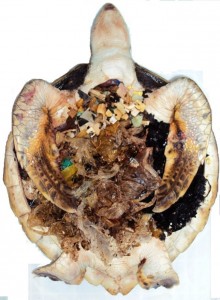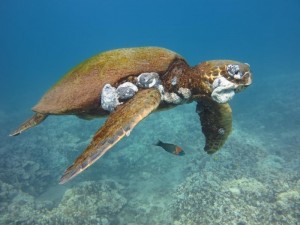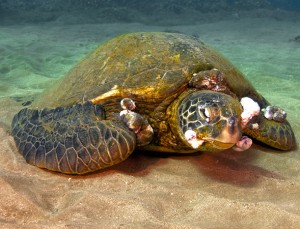Pollution
Pollution is a major cause of the endangerment of sea turtles because it negatively affect the sea turtles in more than one way.
- Oil spills
Although oil spills are not very common, the negative effects on the environment is drastic. The oil can get into the eyes and nose of the turtles when they come up to the surface to breathe. Even though turtles are not as vulnerable to the external environment, they are susceptible to chemical exposure due to the food they consume. Also, currents from the ocean are likely to bring the oil near coastal areas where the turtles breed and nest.
A beach contaminated with oil affects the sea turtles even before it is hatched. If contaminated, the eggs might not hatch and if it hatches, development of the turtles might be disrupted. Moreover, oil spills cut down the supply of food to sea turtles and threaten its survival. With both direct and indirect long-lasting impacts to the sea turtles, it is no surprising that their survival is threatened.
- Plastic Waste
Let us first look at how much plastic gets into the ocean. According to the United Nation Environment Programme, 60-90% of waste hauled up from the ocean contains plastic and shockingly every year, 6.5 billion kilograms of plastic waste is conveniently thrown into the ocean. Some of the waste in the water will be carried by the currents into the Great Pacific Garbage Patch also known as the “Plastic Continent”. 70% of the wastes that stays in the ocean sink and settle on the sea bed, negatively affecting the ecosystem because exchanges between the water and sediments cannot take place.
Increasingly, many products are made of plastic. Common waste include bottles, bags, and packing materials made of plastic. These plastic products either get washed out from the shore or are carried by wind into the water. As plastics are non-biodegradable, they only break down to smaller pieces and these smaller pieces are even more toxic.
Plastic can be mistaken as food for turtles. Smaller pieces of plastic are more toxic and when it gets absorbed into the body of the turtles, it affects the entire food chain. Bigger pieces of plastic takes up the stomach space and they will not be able to consume food, leading to starvation.
When plastic gets trapped in the turtles, the harmful decomposition of debris produces gas in the stomach. The trapped gas cause turtles to float and it may either lead to starvation or them becoming easy prey for other animals.Turtles also sometimes get trapped in plastic items (e.g. fishing nets made of nylon that does not decompose easily) and often unable to release themselves out of it, causing them to sometimes starve or affect their development and growth.
- Other forms of pollution
There are other forms of pollution that can harm the marine environment, many impacts of such pollution cannot be seen immediately.
– Wastewater: untreated or incomplete treatment of sewage
– Chemical pollution in the form of toxic waste from factories and the dumping of pharmaceutical products
– Bacteriological pollution in the form of human and animal waste
– Radioactive waste such as the radioactive water used to cool reactors (e.g. Fukushima nuclear power plant in 2011)
– Heavy metals and persistent organic pollutants (POPs) take a very long time to break down and can stay in the environment for quite some time
Due to the pollutants in the water, tumors have been spotted on sea turtles.
– Noise pollution due to maritime transport, consisting of big ships carrying containers and specialized boats that carry more valuable items (minerals, grains, liquid and gas). As the demand for different kinds of goods spread across the globe, more items are being transported not only by air but also across the sea. Unknowingly we are harming the ecology and the habitat of the marine animals including the sea turtles.




